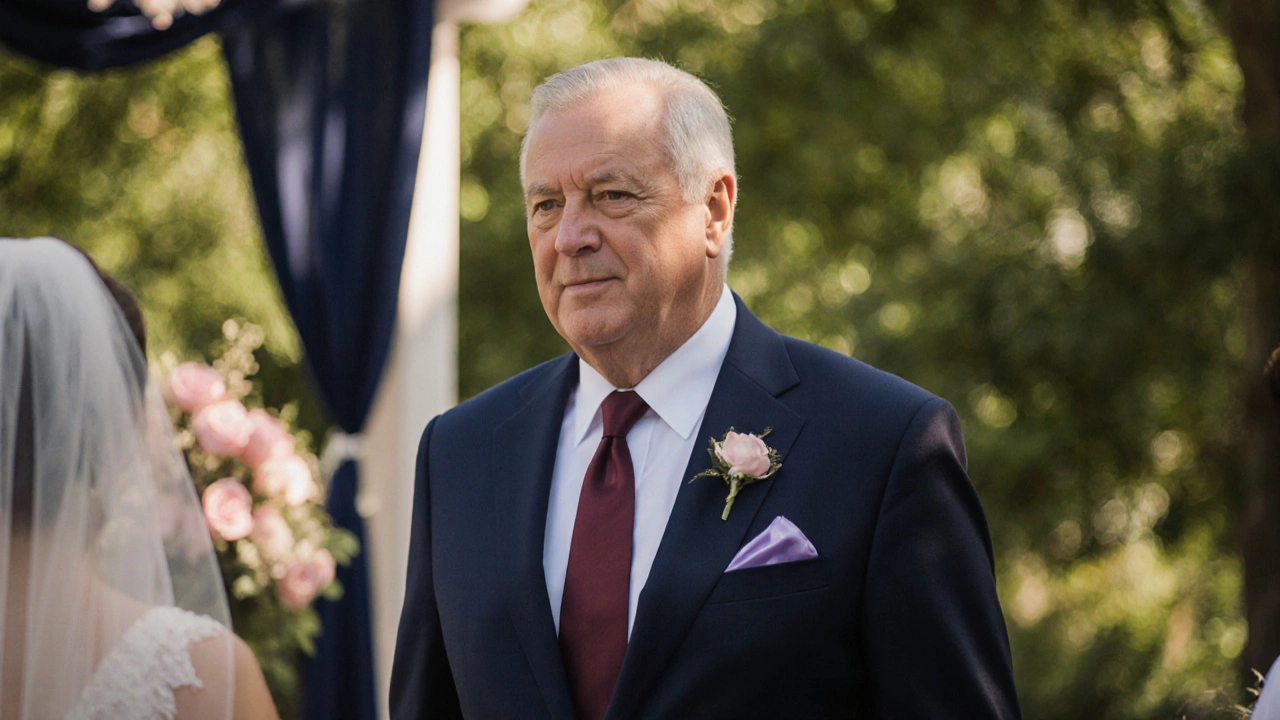
Choosing the right color for the father of the groom is one of those subtle details that can make a wedding look polished or feel off‑balance. Too bright and he steals the spotlight; too dull and he looks like an afterthought. This guide walks you through the key decisions - from the overall wedding palette to the season, time of day, and how to coordinate with the rest of the family - so you can pick a shade that feels right, looks sharp, and blends seamlessly with the celebration.
Quick Takeaways
- Stick to classic neutrals (navy, charcoal, deep green) for most weddings.
- Match the father’s color to the wedding theme, not the bride’s dress.
- Consider season and venue: lighter tones for spring/summer outdoors, richer tones for fall/winter indoors.
- Avoid white, ivory, and overly bright shades that clash with the bridal party.
- Coordinate accessories (tie, pocket square, shoes) to echo the wedding’s accent colors without matching exactly.
Understanding the Wedding Color Palette
The first step is to get a clear picture of the wedding color palette. Couples usually pick one main color and one or two accent colors for décor, flowers, and stationery. Those hues set the visual tone for the entire event.
Ask the couple (or the wedding planner) for the hex codes or fabric swatches they’re using. If the palette features navy and blush, a navy suit for the father of the groom will echo the primary color while still keeping him distinct from the groom’s tuxedo. If the accents are emerald and gold, a deep green suit can subtly mirror that richness without competing with the groom’s outfit.
Seasonal and Time‑of‑Day Considerations
Season influences both comfort and color psychology. Here’s a quick rundown:
- Spring (Mar‑May): Light greys, soft blues, and pastels work well for outdoor ceremonies.
- Summer (Jun‑Aug):** Linen or lightweight wool in beige, light navy, or dusty rose keep things breezy.
- Fall (Sep‑Nov):** Rich tones like burgundy, forest green, and charcoal blend with autumn foliage.
- Winter (Dec‑Feb):** Deep navy, midnight black (only for formal evenings), or dark plum create a luxe feel.
The time of day matters too. Daytime weddings favor lighter fabrics and colors; evening affairs allow darker, more formal shades. A charcoal suit with a silk tie feels appropriate for a 7p.m. reception, while a light grey suit might look out of place after dark.
Dress Code Basics: Formal vs. Semi‑Formal
Most couples specify a dress code on their invitations. The two most common categories are:
- Formal - black tie or black tie optional. A classic tuxedo (black or midnight blue) is expected.
- Semi‑formal - a dark suit with a dress shirt and tie.
If the invitation calls for “black tie,” the father of the groom should wear a tuxedo, typically in black or midnight blue. If it says “formal” without the “black tie” qualifier, a dark suit (navy, charcoal) paired with a formal shirt and tie is acceptable. When the invite simply states “cocktail attire,” a smart blazer and slacks in a complementary shade works fine.
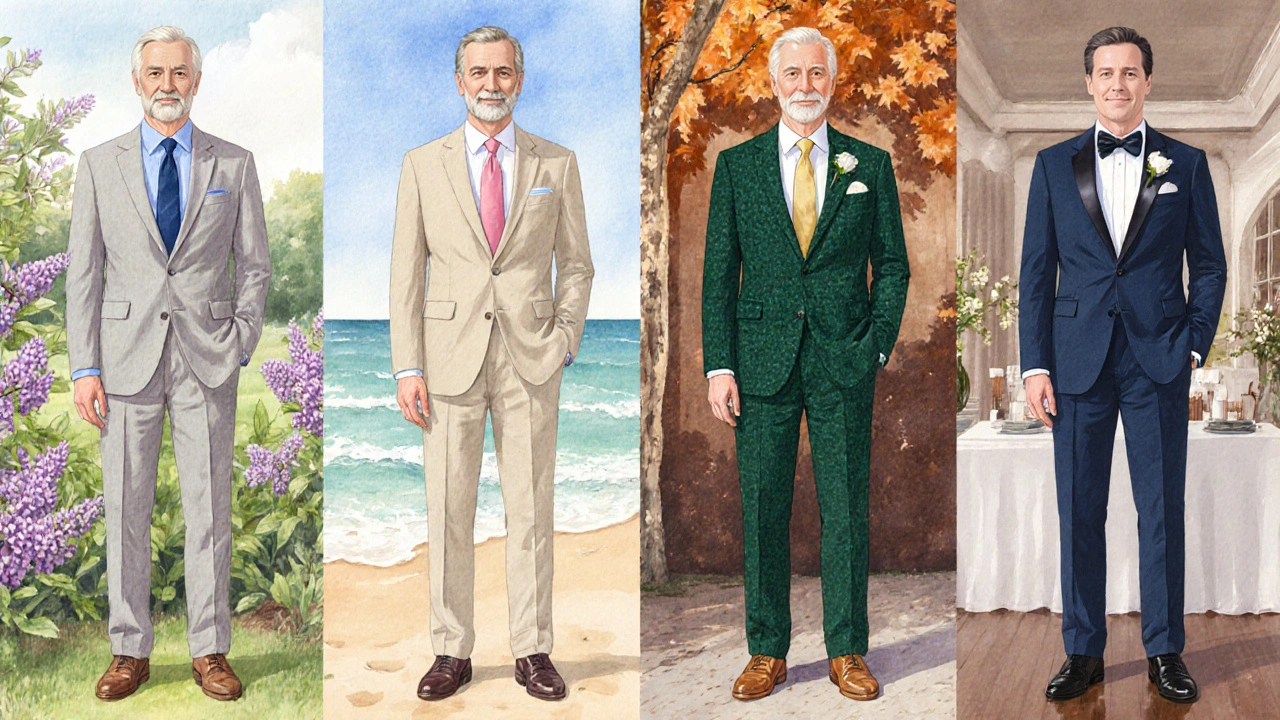
Choosing the Right Color
Below is a handy comparison of the most popular colors and when they shine:
| Color | Best For | Typical Pairings |
|---|---|---|
| Navy | All seasons, especially spring/summer day events | White shirt, burgundy or silver tie, pocket square matching accent |
| Charcoal | Fall/winter evenings, formal settings | Light blue shirt, patterned tie, dark leather shoes |
| Deep Green | Autumn outdoor, rustic venues | Cream shirt, gold tie, tan brogues |
| Light Grey | Daytime summer, beach or garden | Pale pink shirt, navy tie, white sneakers (smart‑casual) |
| Midnight Blue Tuxedo | Black‑tie evenings, upscale hotels | White bow tie, cummerbund, patent leather shoes |
Notice how each color is linked to a setting rather than a rigid rule. The goal is to pick a shade that feels natural for the venue, weather, and overall vibe.
Coordinating with the Bride’s Mother and Other Family
Harmony among the parents avoids visual clashes. Here are three quick steps:
- Share the dress code and color palette with the bride’s mother early.
- Choose complementary, not matching, colors. If she’s wearing a soft lavender dress, the father could wear a navy suit with a lavender pocket square - a nod, not a copy.
- Avoid opposite extremes. Don’t pair a bright red suit with a pastel bridal mother’s dress; the contrast will be jarring.
When both parents are from the same side of the family, a coordinated look (matching jackets or shirts) can create a cohesive block of color, especially in formal weddings.
Accessories: Ties, Pocket Squares, Shoes, and More
Accessories are the place to inject the wedding’s accent colors without overwhelming the outfit.
- Tie - Choose a silk tie that reflects an accent hue (e.g., rose gold if that’s a secondary color). Subtle patterns like stripes or small paisley add visual interest.
- Pocket square - A single‑fold pocket square in the same shade as the tie’s pattern creates a polished link.
- Shoes - Dark leather oxford or brogue shoes pair well with navy or charcoal. For lighter suits, consider tan loafers for a relaxed feel.
- Cufflinks - Simple silver or onyx pieces work for formal events; wooden or enamel cufflinks can add personality at semi‑formal gatherings.
Remember, accessories should complement, not duplicate, the bride’s bouquet or centerpiece colors. A single accent in the tie or pocket square is enough.
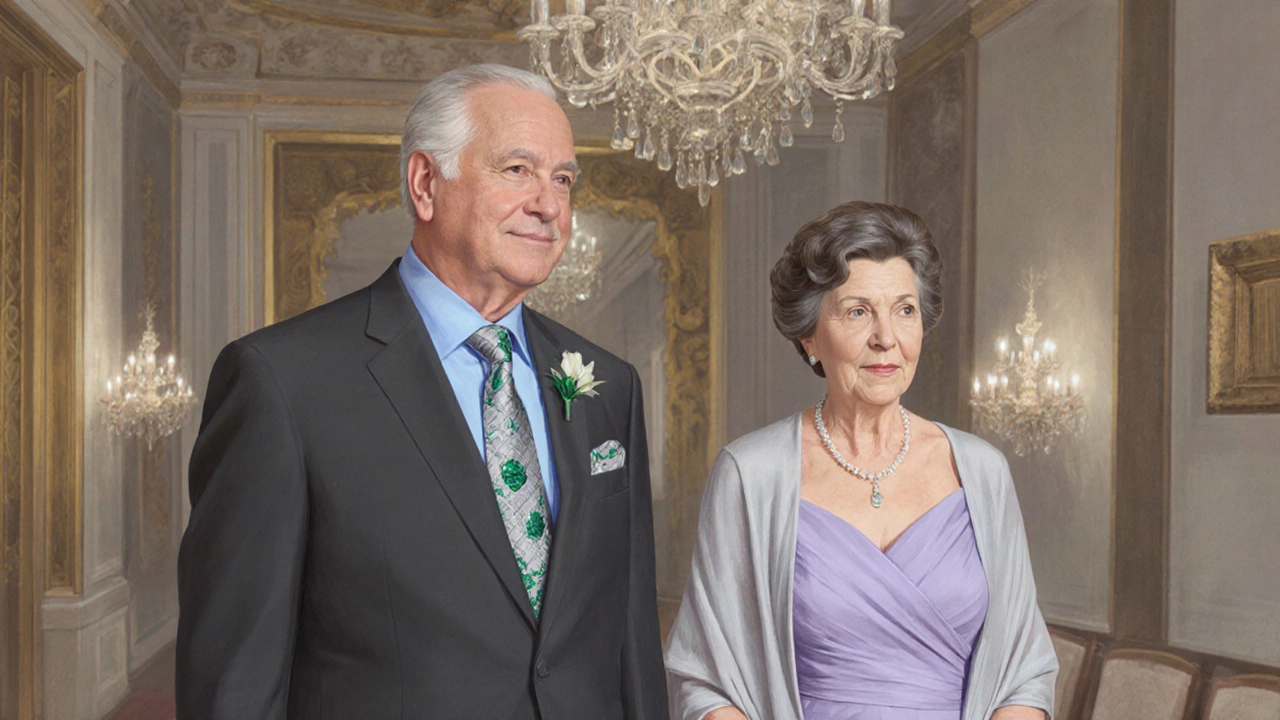
Where to Buy or Rent - Practical Tips
Buying a brand‑new suit is a big investment, but renting offers flexibility, especially if the father’s wardrobe already has a suitable base piece.
- Start the search 4-6weeks before the wedding. This gives time for alterations.
- If renting, request a fabric swatch to ensure the color matches the palette precisely.
- For purchases, look for retailers that offer a “made‑to‑measure” service - the fit will be spot‑on, and you can choose the exact shade.
- Check return policies. Some shops allow a free exchange within 30days if the color or fit isn’t right.
Budget‑friendly options include department store tailoring departments, online custom suit makers, and specialty men’s boutiques that cater to wedding parties.
Common Pitfalls and How to Avoid Them
Even well‑intentioned fathers can slip up. Here are the most frequent errors and quick fixes:
- Showing up in white or ivory. Those shades belong to the bride and sometimes the bride’s mother. Switch to a neutral tone like tan or grey.
- Choosing a color that clashes with the groom’s outfit. If the groom is in a classic black tuxedo, a navy or charcoal suit for the father creates contrast without competition.
- Ignoring the season. Heavy wool in July will be uncomfortable; opt for linen or lightweight blends.
- Over‑matching the bride’s mother. Aim for harmony, not identical looks. Choose a complementary hue instead.
By checking each of these points against the wedding details, the father of the groom can walk in feeling confident and looking sharp.
Frequently Asked Questions
Can the father of the groom wear black at a daytime wedding?
Black is traditionally reserved for evening or formal black‑tie events. For a daytime wedding, a dark navy or charcoal suit feels more appropriate and lighter in appearance.
What if the wedding’s main color is pink?
Avoid a pink suit unless the whole look is deliberately bold. Instead, choose a neutral like navy or grey and incorporate pink through a tie or pocket square that matches the bridal accents.
Should the father of the groom wear a tuxedo if the groom is in a suit?
Generally, no. Matching the groom’s level of formality keeps the party balanced. If the groom is in a classic suit, the father should opt for a suit in a complementary color.
Is it okay to wear a patterned suit?
A subtle pattern like a fine check or faint pinstripe can work, especially for semi‑formal weddings. Keep the rest of the outfit - shirt, tie, shoes - simple to avoid looking busy.
How far in advance should the father of the groom order his outfit?
Aim for 4-6weeks before the wedding. This window allows for tailoring, color matching, and any last‑minute adjustments.
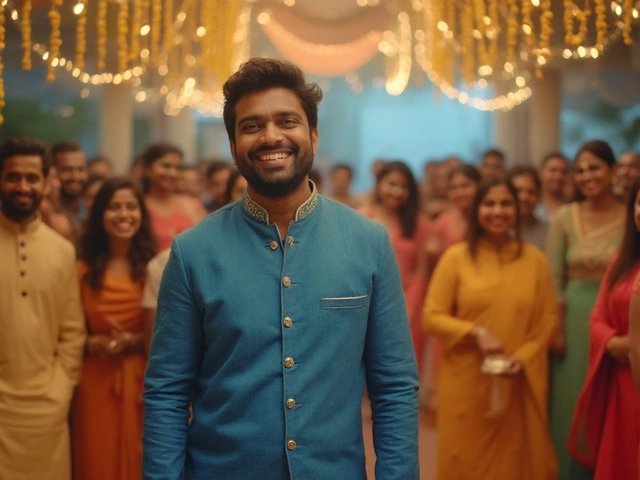
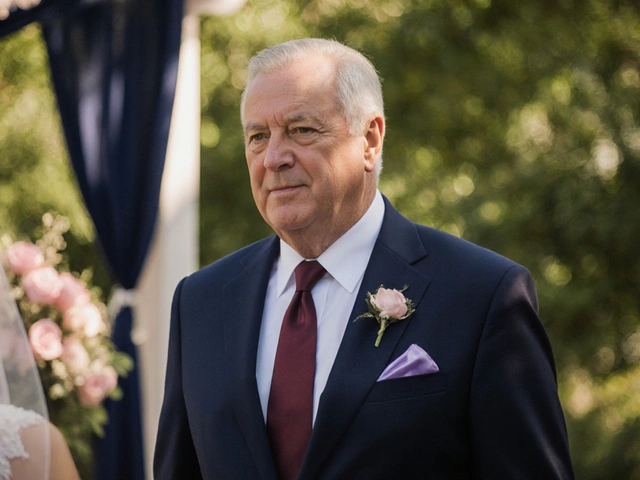

Comments
Post Comment